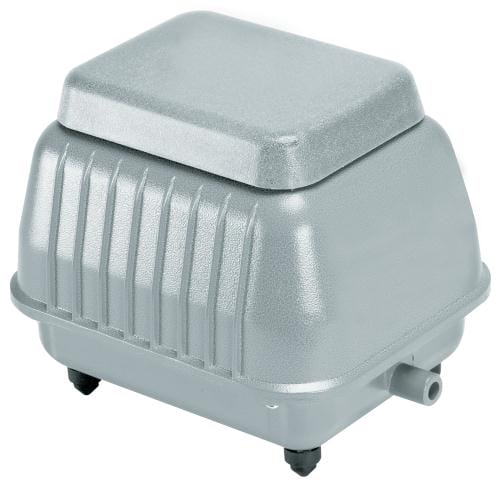Hydroponics is an innovative method of growing plants without the use of soil. Instead, it utilizes water and essential nutrients to nourish the plants’ roots. With this technique, gardeners have better control over the plant’s growth, resulting in healthier and more abundant harvests. However, for hydroponics systems to thrive, they require a constant supply of oxygen to the plants’ roots. This is where an air pump for hydroponics comes into play. In this article, we will explore the benefits of using an air pump for hydroponics and how it can improve your gardening experience.
Improves Oxygen Levels in the Water

One of the main benefits of using an air pump for hydroponics is that it helps improve oxygen levels in the water. Plants need oxygen to survive, just like humans do. In traditional soil-based gardening, the soil contains pockets of air that allow for the exchange of oxygen and carbon dioxide between the roots and the atmosphere. However, in a hydroponic system, there is no soil to provide this necessary oxygen. Without proper oxygenation, the plants’ roots can become waterlogged and suffocate, leading to stunted growth or even death.
An air pump works by pumping air through tubes and into the water in the hydroponic system. As the air bubbles rise to the surface, they create a continual flow of oxygen-rich water around the roots, ensuring that they receive the necessary oxygen for optimal growth. Additionally, the constant motion caused by the bubbles also prevents the roots from becoming stagnant, reducing the risk of root rot.
How Does an Air Pump Work?
An air pump for hydroponics usually consists of an electric motor connected to an air valve. As the motor runs, it pumps air through tubes connected to the valves, which then release the air into the water. You can control the flow of air by adjusting the valve’s settings, allowing you to customize the amount of aeration for your specific plants’ needs.
The Benefits of Using an Air Pump with Multiple Outlets
Some hydroponic gardeners opt for air pumps with multiple outlets, which allow for more precise control over the oxygen levels in the water. With multiple outlet pumps, you can connect different tubes to various areas of your hydroponic system, providing targeted aeration to different plants or sections. This also allows you to adjust the airflow to each plant’s needs, depending on their growth stage and size.
Types of Air Pumps for Hydroponics
There are several types of air pumps available in the market for hydroponics systems. The most common ones are diaphragm pumps, piston pumps, and air stone pumps. Each type has its benefits and limitations, so it is essential to consider your specific needs before purchasing one.
Diaphragm Pumps
Diaphragm pumps are the most commonly used air pumps for hydroponics. They are economical, easy to use, and require minimal maintenance. These pumps work by using rubber membranes to compress and release air, creating a steady flow of bubbles. However, diaphragm pumps tend to be louder than other types of air pumps, so they may not be suitable if you are sensitive to noise.
Piston Pumps
Piston pumps are another popular choice for hydroponic gardeners. They are more powerful than diaphragm pumps and produce larger bubbles, making them ideal for larger hydroponic systems. These pumps use pistons to draw in and push out air, resulting in a more consistent and powerful airflow. However, they tend to be more expensive than diaphragm pumps and may require more maintenance.
Air Stone Pumps
Air stone pumps are best suited for small hydroponic systems or as supplemental aeration for larger systems. These pumps work by using an air stone to create tiny bubbles that rise to the surface, providing oxygen and water circulation. They are relatively quiet and inexpensive, but they may not be powerful enough for larger hydroponic setups.
Enhances Nutrient Absorption

In addition to providing essential oxygen to the plants’ roots, an air pump can also enhance their nutrient absorption. In a hydroponic system, plants receive nutrients through the water in which their roots are submerged. However, without proper aeration, these nutrients can become stagnant, leading to imbalances and deficiencies in the plants’ uptake.
When the water is adequately aerated, the nutrients remain in constant motion, preventing them from settling at the bottom of the reservoir. This ensures that all the plants’ roots have equal access to the necessary nutrients, resulting in healthier and more robust plants. Additionally, the bubbling action caused by the air pump also helps break down any organic matter in the water, making it easier for the plants to absorb the nutrients.
Best Practices for Using an Air Pump to Enhance Nutrient Absorption
To maximize the benefits of using an air pump for nutrient absorption, there are a few best practices to keep in mind. First, make sure to position the air pump in a way that creates a circular motion in the water. This will ensure that all areas of the reservoir receive adequate aeration and circulation. Additionally, it is crucial to regularly clean and replace the air stones or diffusers to prevent clogging, which can hinder the airflow and nutrient absorption.
Measuring Oxygen Levels in the Water
To determine if your hydroponic system has sufficient oxygen levels, you can invest in an oxygen meter. An oxygen meter measures the dissolved oxygen in the water, giving you an accurate reading of the oxygen levels in your system. The optimal range for oxygen levels in a hydroponic system is between 8-10 mg/L. If your levels fall below this range, you may need to increase the airflow or consider investing in a more powerful air pump.
DIY Air Pump vs. Store-Bought
Some hydroponic gardeners opt for DIY air pumps, using household items like aquarium pumps or even bellows made out of plastic bottles. While these alternative options may work, they may not be as efficient or consistent in providing adequate oxygenation. Additionally, they may require frequent maintenance and replacement, making them more costly in the long run. Investing in a store-bought air pump specifically designed for hydroponics is often the better option for consistent and reliable results.
Reduces the Risk of Harmful Bacteria

In traditional soil-based gardening, beneficial bacteria help break down organic matter in the soil, providing essential nutrients to the plants. In a hydroponic system, there is no soil, so it relies heavily on the water’s bacteria population. However, without proper aeration, harmful bacteria can quickly multiply, posing a threat to the plants’ health.
An air pump helps prevent the growth of unwanted bacteria by creating a highly oxygenated environment that is not conducive for their growth. As the water circulates and flows around the roots, it also carries away any accumulating waste products, reducing the risk of bacterial overgrowth. This leads to a healthier root system, resulting in healthier and more abundant plants.
Beneficial Bacteria in Hydroponics
While air pumps reduce the risk of harmful bacteria, it is still crucial to introduce beneficial bacteria into your hydroponic system. These good bacteria play a vital role in breaking down organic matter and converting it into essential nutrients for the plants. They also help maintain a balanced pH level and prevent the build-up of algae and other harmful substances.
How to Introduce Beneficial Bacteria into Your Hydroponic System
You can introduce beneficial bacteria into your hydroponic system through a variety of methods. One way is to use a hydroponic-specific microbial product, which contains a blend of beneficial bacteria and enzymes. These products are safe for plants and provide an easy and efficient way to boost your system’s bacteria population. Another option is to add organic matter, such as compost tea, to the water to introduce natural bacteria. However, it is essential to regularly clean and maintain your system to prevent the growth of harmful bacteria.
Saves Time and Energy

Another significant benefit of using an air pump for hydroponics is that it saves you time and energy in maintaining your system. With proper aeration, you can reduce the need for frequent water changes and cleaning. Without an air pump, you may need to replace the water more often, as it becomes stagnant and accumulates waste products and harmful bacteria.
Additionally, the bubbling action caused by the air pump also helps prevent algae growth. Algae can quickly multiply in a hydroponic system, especially if exposed to sunlight. Cleaning out algae can be a time-consuming task, but with proper aeration, you can significantly reduce its occurrence, saving you time and effort.
How to Maintain Your Air Pump
To ensure that your air pump continues to function efficiently, it is essential to perform regular maintenance. This includes cleaning or replacing the air stones or diffusers, as they can become clogged with debris over time. You should also check the tubes and valves for any cracks or leaks and replace them if necessary. Additionally, it is crucial to clean the pump itself, as dirt and dust can accumulate and affect its performance.
Essential Tools for Air Pump Maintenance
To maintain your air pump, you will need a few essential tools, including:
- Soft-bristled brush
- Hydrogen peroxide
- White vinegar
- Clean cloth or paper towels
- Replacement air stones or diffusers (if necessary)
To clean the air pump, soak the air stones or diffusers in a mixture of hydrogen peroxide and water for at least 30 minutes. Then use the soft-bristled brush to scrub away any remaining debris. For the pump itself, you can use a mixture of half white vinegar and half water to clean the motor and other parts. Wipe it down with a clean cloth or paper towels and let it air dry before reassembling.
FAQs

What size air pump do I need for my hydroponic system?
The size of the air pump you need depends on the size of your hydroponic system. As a general rule, you should aim for an airflow rate of 1 liter per minute (LPM) per gallon of water in your system. For example, if you have a 10-gallon system, you will need an air pump that can deliver at least 10 LPM.
Do I need an air pump for all types of hydroponic systems?
While an air pump is not necessary for all types of hydroponic systems, it is highly recommended for most. Deep water culture (DWC) and nutrient film technique (NFT) systems, which involve plants’ roots being submerged in water, require constant aeration. However, wick and drip systems may not require an air pump, as they rely on gravity to deliver nutrients to the plants’ roots.
Can I use an aquarium air pump for my hydroponic system?
In some cases, you can use an aquarium air pump for a small hydroponic setup. However, they are not as powerful as air pumps specifically designed for hydroponics and may not provide adequate aeration for larger systems.
Can I run my air pump 24/7?
Yes, it is recommended to run your air pump 24/7 to ensure a constant supply of oxygen to your plants’ roots. However, some hydroponic gardeners prefer to use a timer to schedule the air pump’s operation, especially if they have multiple plants with different oxygen needs.
Can I use an air pump in my outdoor hydroponic system?
Yes, you can use an air pump in an outdoor hydroponic system. However, it is essential to protect the pump from rain and other elements that may damage it. You can use a weatherproof box or shelter to protect the pump while still allowing for proper airflow.
Conclusion
Using an air pump for hydroponics provides numerous benefits, such as improving oxygen levels in the water, enhancing nutrient absorption, reducing the risk of harmful bacteria, and saving time and energy. Whether you are a beginner or experienced hydroponic gardener, investing in a reliable and efficient air pump can greatly improve your plants’ health and growth. Remember to consider the size and type of your hydroponic system when choosing an air pump and maintain it regularly for optimal results. With proper aeration, you can enjoy healthier, more abundant harvests from your hydroponic garden.
